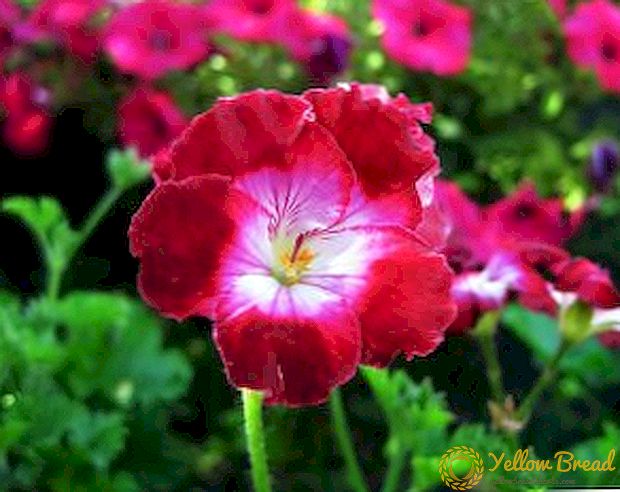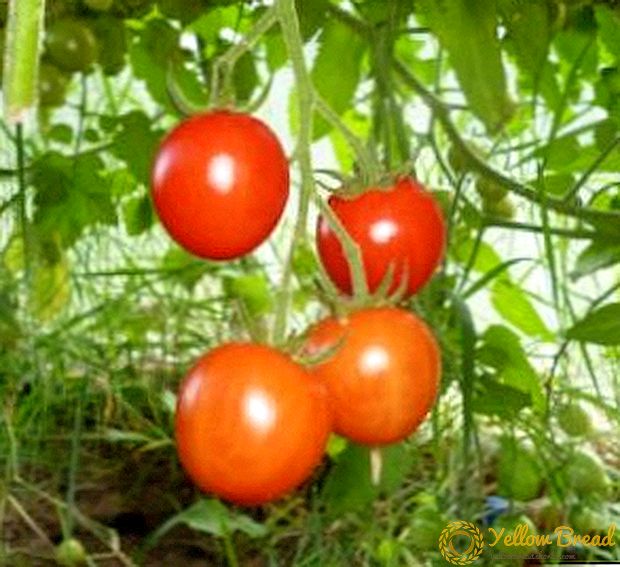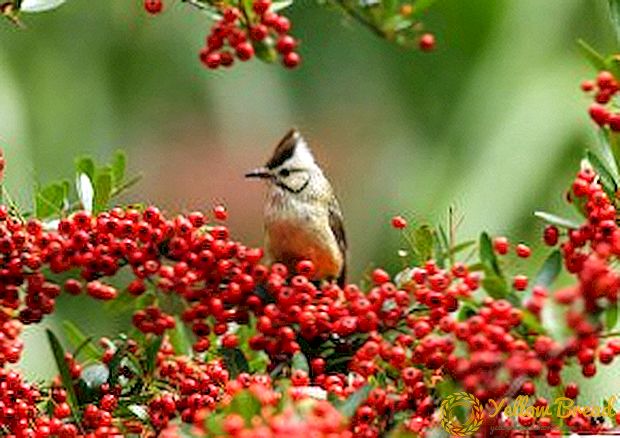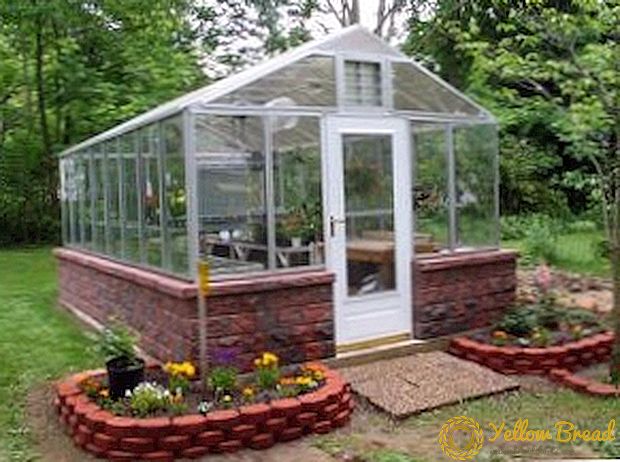 Abutilon is a decorative deciduous and flowering plant of the family Malvaceae, its dissected, carved leaves are similar in shape to the maple foliage. How to grow maple abutilon at home, we discuss in this article.
Abutilon is a decorative deciduous and flowering plant of the family Malvaceae, its dissected, carved leaves are similar in shape to the maple foliage. How to grow maple abutilon at home, we discuss in this article.
- Short description
- Choosing a place for a plant
- Lighting and temperature
- Pot and soil type for home maple
- Proper care
- Watering
- Fertilizer
- Pruning
- Transplant rules
- Reproduction culture
- Diseases, pests and possible difficulties in growing
Short description
Abutilon is a perennial shrub with large, up to 20 cm bright green leaves with carved edges. At home, the bush reaches two meters in height, branchy and leafy, the plant stems are often red-brown in color.
Bushes bloom in May and blooms through October inclusive. Depending on the type of flowers, bells can be golden, orange, pink and red shades. The most common types are:
- Abutilon sellovianum - two meters high, inflorescences are large orange in color with burgundy streaks;
- Abutilon hybridum - its subspecies bloom yellow, pink, purple, maroon and red flowers with thin veins;
- Abutilon Thompsonii - with pale pink inflorescences interspersed with white.
Choosing a place for a plant
Abutilon is a frequent visitor to greenhouses and winter gardens, and if the necessary conditions are met, the home maple develops well in indoor conditions.

Lighting and temperature
For a plant, diffused lighting is preferable, direct sunlight can burn the leaves, and a lack of light will affect the development of green mass. The best option would be a place at the southwest or southeast window. During the winter period, a light day is short, so it is desirable to provide the maple with several hours of additional lighting.
The most comfortable temperature for maple is the range from 18 to 25 degrees heat.In late spring, you can take the plant to the loggia or veranda, but in this case there should be no drafts. In winter, the temperature of the content drops to 15 ° C.
Pot and soil type for home maple
For the first year there will be enough a pot with a liter volume. The indoor abutilon has one feature: as long as its roots do not overlap the entire lump of soil in the pot, it will not bloom. Next, select the pot, focusing on the drainage holes at the bottom, if you can see the roots in them, it's time to transplant. At the bottom of the pot to drain water must be holes.
If possible Prepare the soil yourself, there are two options to choose from:
- coarse sand, peat and leaf earth in equal parts;
- coarse sand, humus, sheet and sod land in proportions 0.5: 1: 1: 2.
If this is not possible, use a universal primer, adding sand to it.
Proper care
Natural conditions of the shrub - subtropical and tropical climate, but At home, care has some subtleties:
- it is not desirable to allow neither drying out nor over-moistening of the soil in the pot;
- correctly dispense top dressings and timely conduct trimming of the bush.
Watering
Home maple abutilon in the summer period needs regular abundant moisture, it is necessary to ensure that the soil in the pot was constantly moistened. By winter, watering is gradually reduced, bringing to a minimum. There are no special requirements for air humidity in the plant, but spraying will not harm it. Watering in the summer - twice a week, in the winter - once every ten days.
Fertilizer
As a fertilizer for shrubs, it is better to purchase a complex for flowering plants in a store, it is desirable to alternate between mineral and organic compounds. In plant nutrition, the plant needs the entire period from spring to October with an interval of ten days.

After spring pruning to build foliage better suited compositions with a large amount of nitrogen. During the formation of buds it is better to use phosphorus-potassium compounds, they will favorably affect the flowering splendor. In winter, fertilize once a month if the shrub continues to bloom.
Pruning
Abutilon is characterized by rapid growth and the formation of new shoots, because he needs a formative pruning.In early spring, while growth is not active, shoots are pruned to a third of their length. Such cardinal pruning will form a beautiful crown shape and stimulate abundant flowering.
When the plant ottsvetet, remove all withered buds, dry branches, carry out the adjustment of the crown for the winter. In order to form a mini-tree, all side shoots should be cut, leaving at least the length and untouched central stem.
Transplant rules
The signal for the desired transplant is fast absorption of moisture, the pet does not have enough space for development. It is advisable not to take a pot that is too different in diameter, because the flower is growing very quickly.
Reproduction culture
Reproduction home maple possible cuttings and seed method.
Sowing of seeds is carried out in March in a moist soil (peat and sand in the same proportions), to a depth of about 1.5 cm.
The box is covered with film and placed on a warm, well-lit window sill. Recommended temperature for germination is 20 ° C. Within twenty days, the first shoots appear. Due to the rapid growth over the summer, they are transplanted about three times.
The cuttings are cut from the upper shoots up to 12 cm long. The lower leaves are removed, the bottom of the shoot is treated with a root formation stimulator and deepened into the nutrient soil. For the best rooting for cuttings construct a mini-greenhouse, regularly airing it. After a few weeks, the shelter is removed and the top is pinched. Subsequently, a young abutilon receives the same care as an adult plant.
Diseases, pests and possible difficulties in growing
The main pests of the room maple are spider mites, scutes, aphids, and mealybugs.
Fight insects insecticide preparations and some measures will help:
- Mite appears in case of great dryness. Having treated the plant acaricide, you need to increase the humidity of the air by spraying, wiping the foliage with a damp cloth.
- You can remove aphids from the leaves using a soap solution, rinse them under running water.
- The mealybug is removed with a cotton pad moistened with alcohol.

Effective preparations against insects: "Decis", "Pyrethrum", "Aktellik".
Powdery mildew is a common plant disease. To notice the symptoms of the disease is not difficult - the leaves are covered with a sticky coating and brown growths. To get rid of maple from the disease, you can use the drug "Aktara" and washing the leaves with soap and water.
Another common problem is root rot. You can help the plant if you immediately notice the symptoms (withering and falling leaves) and transplant. Root-affected roots should be cut and crushed with crushed coal.
As a preventive measure against diseases, you can use a solution of iron chelate according to the instructions.

Problems with cultivation are mainly due to errors in care. Blooming buds, yellowing foliage, wilting and twisting is Signals for the following care gaps:
- temperature drops (draft);
- waterlogging or, conversely, lack of moisture;
- excessive dryness of the air;
- lack of trace elements;
- strong crown thickening.






